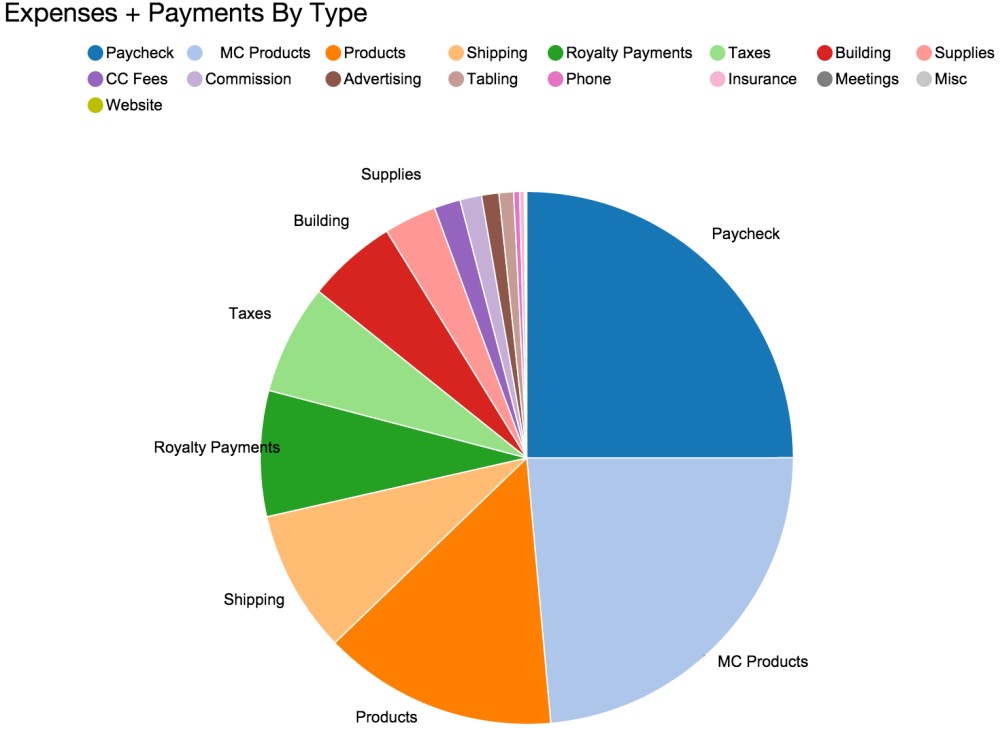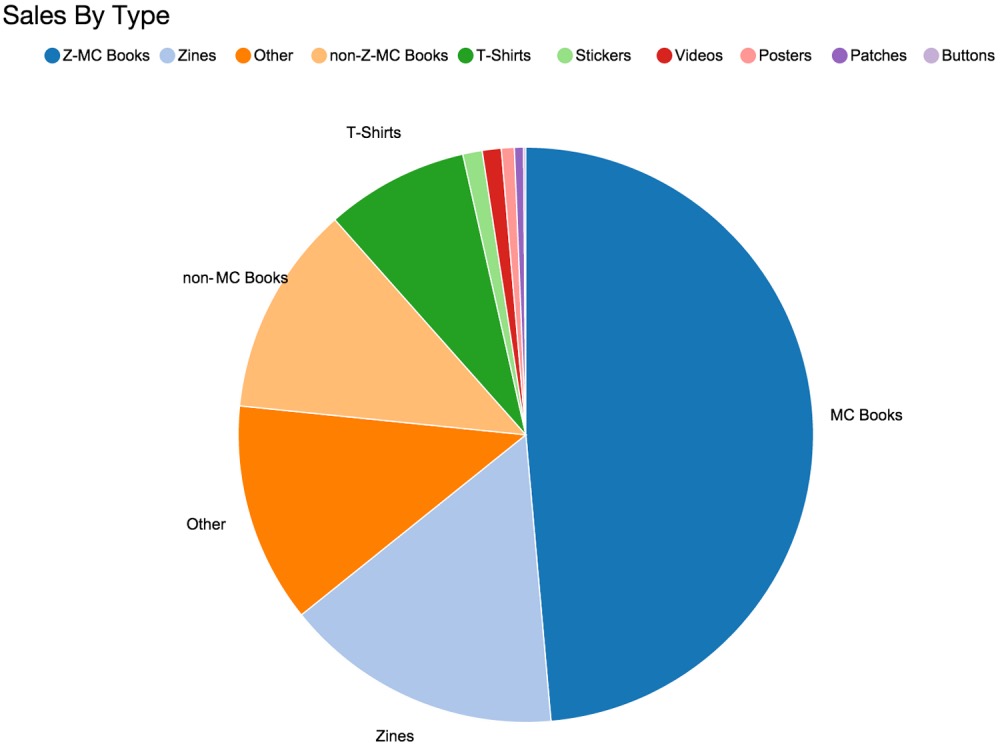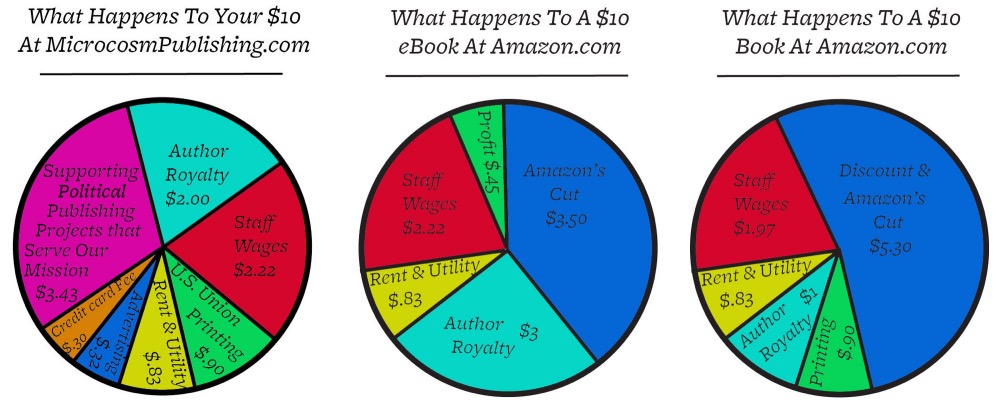Hello Small World,
Elly here, your new Microcosm marketing director. Starting today, I’ll be working at pretty much every level to get all our books into the right hands, and also to continue publishing my line of feminist books about bicycling and getting new editions ready of the two books I wrote for Microcosm. I’m stoked. My first post here at ye olde blogifesto is about everyone’s favorite topic: accounting! Starting in 2009, we’ve published our finances at the beginning of every year. It’s helped both us and our fans keep tabs on how and what the company is doing. We’re proud to be able to be this transparent. We’re also proud (and exhausted, and relieved) that 2014 was our best year EVER by every metric that matters to us.
Before I start bombarding you with numbers, a quick note on how Microcosm works. We operate on a break-even basis, which means: No profits. That is to say, if we are lucky and industrious enough to earn more than our expenses in any given year, that money *does not* get split between owners or shareholders. Instead, it gets put back into the business. Staff get raises and we get to hire more people and we get to take a chance on publishing more books that we love. Also, more sales = more income for the people we work with. Authors get bigger royalty checks, and people whose books we distribute get to sell more books. In short, everyone wins. All of this happened in 2014 and 2015 is looking pretty great already.
Without further ado, here’s a pie chart showing every dollar we spent last year:

Here are the numbers to go with that chart, along with the change since last year:
| Income |
$389,351.59 |
28% increase |
| |
|
|
| Publishing |
$88,505.50 |
33% decrease
|
| Wages |
$102,099.80 |
52.4% increase
|
| Shipping |
$35,539.21 |
15% increase
|
| Distribution |
$59,036.79 |
151.5% increase!
|
| Supplies & Phone |
$14,730.93 |
9.4% decrease
|
| Royalties |
$31,306.46 |
101.1% increase!
|
| Building |
$20,844.05 |
137.3% increase
|
| Advertising |
$4,316.48 |
18.3% decrease
|
| Travel |
$3,620.94 |
68.7% increase
|
| Donations |
$27,325.00 |
78.3% increase
|
| Total |
$387,325.16 |
28.2% increase |
|
|
|
| Profit |
$2,026.43 |
(goes into 2015 expenses) |
In short, we spent a lot more on existing staff wages and hiring rad new people, a whole lot more on books that we distributed, and a whole heck of a lot more on our office/store/warehouse (we bought a building!). We spent more on travel to sell books and speak at various events, we donated more books to causes and organizations that we support. We paid out twice as much in author royalties as we did in 2013, even though we spent considerably less money publishing (and advertising) books. And we came out a little ahead, which gives us a buffer for the first few days of whatever 2015 brings.
We had a tough few years back there, but I’d say we’ve (finally!) officially bounced back. We’ve paid off all of our debts (and some other people’s too) and everyone’s getting paid regularly, on time, and more than ever (that’s the flip side of owners not splitting profits—when the company loses money it comes out of owners’ paychecks and savings accounts and credit lines—but now we’re looking only forward).
Aaaaand here’s what we sold in 2014 (broken down by total revenue from each type of thing) that made this all possible:
As you can see, print isn’t dead—we’re finding that when we go about it thoughtfully and well, publishing books still makes a lot of financial sense. Unfortunately, there’s a ton of mythology going around to the contrary. I’m sure you’ve heard about the great benefits to authors of self-publishing through a certain giant online retailer. I mean, Amazon will give you a 70% royalty on your ebook! Who can compete with that?
But with all respect, it’s smoke and mirrors. Amazon loves to pit authors (and readers) against what it paints as the greed and ineptitude of publishers—but often people optimistically forget to notice that Amazon is the biggest, most greedy publisher of all. We’re still shaking our heads at
this 2012 Guardian article breaking down author royalties from Amazon. In terms of self-publishing, it’s still way way better to skip the e-books and print on demand and do it in large runs of offset print books—as
this breakdown by Joe on my blog earlier this year shows—essentially launching a traditional publishing company. For those disinclined to do so, working with an actual publisher still makes a ton of sense. Ideally, the author-publisher relationship should be a symbiotic one, sharing the hard work of making good books and getting them into the hands of readers who will value them. That’s our goal, and we’re always working to do it better.
Traditional indie publishing (not to be confused with mega-corporate global conglomerate publishing) is still the best: for authors, for readers, and for workers in the publishing industry. Here’s a chart we made showing what happens to each ten dollars you spend buying books from Microcosm and Amazon (which we broke down further into print and electronic because frankly it’s pretty egregious):
So there’s that. Thanks for reading, for cheering us on, for keeping us honest, writing us love letters, submitting your work, and for being a part of this community. We’re stoked about what the next year will bring. Next month we turn 19, so a year from now there will be even more celebrations in store. As well as more pie charts, of course.


